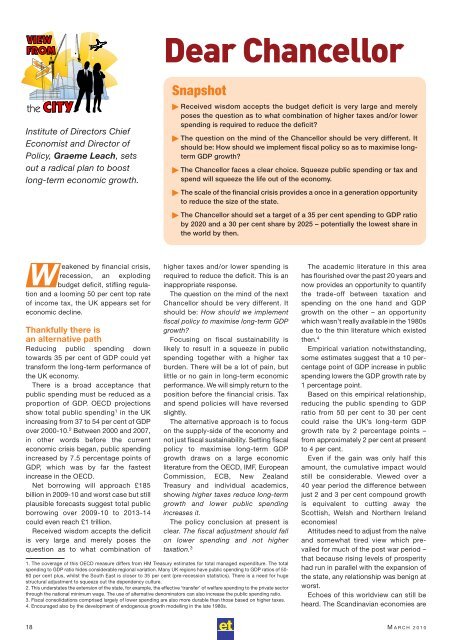Eco Today - Mar10:ET Master Page 2007 - ASKnLearn
Eco Today - Mar10:ET Master Page 2007 - ASKnLearn
Eco Today - Mar10:ET Master Page 2007 - ASKnLearn
Create successful ePaper yourself
Turn your PDF publications into a flip-book with our unique Google optimized e-Paper software.
Dear Chancellor<br />
Institute of Directors Chief<br />
<strong>Eco</strong>nomist and Director of<br />
Policy, Graeme Leach, sets<br />
out a radical plan to boost<br />
long-term economic growth.<br />
Snapshot<br />
Received wisdom accepts the budget deficit is very large and merely<br />
poses the question as to what combination of higher taxes and/or lower<br />
spending is required to reduce the deficit?<br />
The question on the mind of the Chancellor should be very different. It<br />
should be: How should we implement fiscal policy so as to maximise longterm<br />
GDP growth?<br />
The Chancellor faces a clear choice. Squeeze public spending or tax and<br />
spend will squeeze the life out of the economy.<br />
The scale of the financial crisis provides a once in a generation opportunity<br />
to reduce the size of the state.<br />
The Chancellor should set a target of a 35 per cent spending to GDP ratio<br />
by 2020 and a 30 per cent share by 2025 – potentially the lowest share in<br />
the world by then.<br />
W<br />
eakened by financial crisis,<br />
recession, an exploding<br />
budget deficit, stifling regula -<br />
tion and a looming 50 per cent top rate<br />
of income tax, the UK appears set for<br />
economic decline.<br />
Thankfully there is<br />
an alternative path<br />
Reducing public spending down<br />
towards 35 per cent of GDP could yet<br />
transform the long-term performance of<br />
the UK economy.<br />
There is a broad acceptance that<br />
public spending must be reduced as a<br />
proportion of GDP. OECD projections<br />
show total public spending 1 in the UK<br />
increasing from 37 to 54 per cent of GDP<br />
over 2000-10. 2 Between 2000 and <strong>2007</strong>,<br />
in other words before the current<br />
economic crisis began, public spending<br />
increased by 7.5 percentage points of<br />
GDP, which was by far the fastest<br />
increase in the OECD.<br />
Net borrowing will approach £185<br />
billion in 2009-10 and worst case but still<br />
plausible forecasts suggest total public<br />
borrowing over 2009-10 to 2013-14<br />
could even reach £1 trillion.<br />
Received wisdom accepts the deficit<br />
is very large and merely poses the<br />
question as to what combination of<br />
higher taxes and/or lower spending is<br />
required to reduce the deficit. This is an<br />
inappropriate response.<br />
The question on the mind of the next<br />
Chancellor should be very different. It<br />
should be: How should we implement<br />
fiscal policy to maximise long-term GDP<br />
growth?<br />
Focusing on fiscal sustainability is<br />
likely to result in a squeeze in public<br />
spending together with a higher tax<br />
burden. There will be a lot of pain, but<br />
little or no gain in long-term economic<br />
performance. We will simply return to the<br />
position before the financial crisis. Tax<br />
and spend policies will have reversed<br />
slightly.<br />
The alternative approach is to focus<br />
on the supply-side of the economy and<br />
not just fiscal sustainability. Setting fiscal<br />
policy to maximise long-term GDP<br />
growth draws on a large economic<br />
literature from the OECD, IMF, European<br />
Commission, ECB, New Zealand<br />
Treasury and individual academics,<br />
showing higher taxes reduce long-term<br />
growth and lower public spending<br />
increases it.<br />
The policy conclusion at present is<br />
clear. The fiscal adjustment should fall<br />
on lower spending and not higher<br />
taxation. 3<br />
1. The coverage of this OECD measure differs from HM Treasury estimates for total managed expenditure. The total<br />
spending to GDP ratio hides considerable regional variation. Many UK regions have public spending to GDP ratios of 50-<br />
60 per cent plus, whilst the South East is closer to 35 per cent (pre-recession statistics). There is a need for huge<br />
structural adjustment to squeeze out the dependency culture.<br />
2. This understates the extension of the state, for example, the effective ‘transfer’ of welfare spending to the private sector<br />
through the national minimum wage. The use of alternative denominators can also increase the public spending ratio.<br />
3. Fiscal consolidations comprised largely of lower spending are also more durable than those based on higher taxes.<br />
4. Encouraged also by the development of endogenous growth modelling in the late 1980s.<br />
The academic literature in this area<br />
has flourished over the past 20 years and<br />
now provides an opportunity to quantify<br />
the trade-off between taxation and<br />
spending on the one hand and GDP<br />
growth on the other – an opportunity<br />
which wasn’t really available in the 1980s<br />
due to the thin literature which existed<br />
then. 4<br />
Empirical variation notwithstanding,<br />
some estimates suggest that a 10 per -<br />
centage point of GDP increase in public<br />
spending lowers the GDP growth rate by<br />
1 percentage point.<br />
Based on this empirical relationship,<br />
reducing the public spending to GDP<br />
ratio from 50 per cent to 30 per cent<br />
could raise the UK’s long-term GDP<br />
growth rate by 2 percentage points –<br />
from approximately 2 per cent at present<br />
to 4 per cent.<br />
Even if the gain was only half this<br />
amount, the cumulative impact would<br />
still be considerable. Viewed over a<br />
40 year period the difference between<br />
just 2 and 3 per cent compound growth<br />
is equivalent to cutting away the<br />
Scottish, Welsh and Northern Ireland<br />
economies!<br />
Attitudes need to adjust from the naïve<br />
and somewhat tired view which pre -<br />
vailed for much of the post war period –<br />
that because rising levels of prosperity<br />
had run in parallel with the expansion of<br />
the state, any relationship was benign at<br />
worst.<br />
Echoes of this worldview can still be<br />
heard. The Scandinavian economies are<br />
18 M ARCH 2010

















